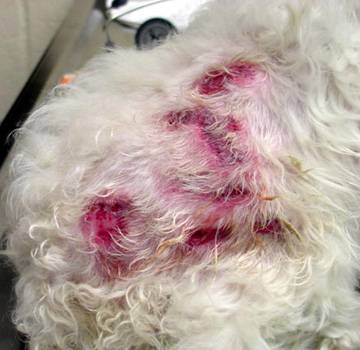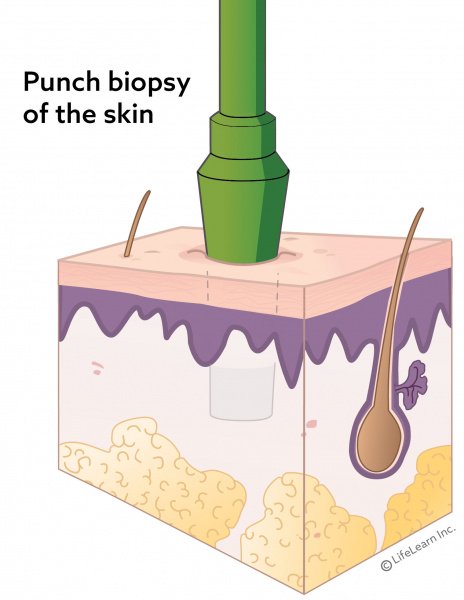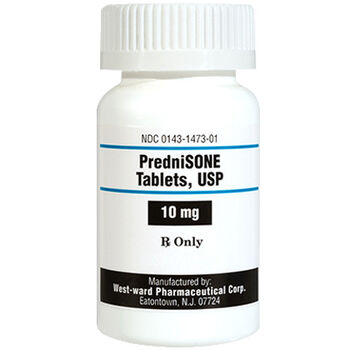I don’t like skin diseases, so I’m very thankful for folks like board-certified veterinary dermatologists who do! This week my family’s dog, Tobyas, required urgent dermatologic care for an immune-mediated condition called idiopathic sterile nodular panniculitis. Thanks to the wonderful veterinary dermatology team at Angell Animal Medical Center in Boston, Massachusetts, Tobyas is now on the road to recovery. This week I’m sharing information about this disease to increase awareness. Happy reading!

What is idiopathic sterile nodular panniculitis?
Panniculitis is the term used to describe inflammation of the panniculus adiposus. The panniculus adiposus is the layer of fatty tissue underneath the skin. Inflammation is triggered by an abnormal immune system response and causes nodules to form. The nodules may be localized to a specific area of the body or they may occur generally throughout the panniculus adipsosus.

The panniculus adiposus may be inflamed for a variety of reasons, including:
- Bacterial infections
- Fungal infections
- Nutritional deficiencies (e.g.: vitamin A)
- Blood vessel disorders
- Pancreatic diseases
- Adverse drug reactions
- Systemic lupus erythematosus
- Trauma
- Adverse reaction to injections
When no underlying disorder can be documented, sterile nodular panniculitis is called idiopathic. Idiopathic is the medical way of saying “We don’t yet know the underlying cause.”
What does it look like?
Idiopathic sterile nodular panniculitis may affect any sex of dog. Young dogs are over-represented, as are certain breeds, including:
- Miniature dachshunds
- Poodles
- Corgis (both Welsh cardigan & Pembroke Welsh)
- Australian shepherds
This disease is characterized by bumps or nodules in the fatty tissue under the skin. Nodules and ulcerated lesions are most commonly found on the trunk. The nodules often ulcerate or erupt, causing open wounds in the skin that drain pus-like, bloody, and/or oily secretions. The lesions can be painful and may become infected. The subcutaneous tissue in affected areas becomes edematous or swollen, and peripheral lymph nodes frequently become enlarged. Affected patients can also be systemically unwell, manifesting a variety of clinical signs, including fever, reduced (or loss of) appetite, lethargy, and depression.

How is idiopathic sterile nodular panniculitis diagnosed?
Veterinarians make a definitive diagnosis of sterile nodular panniculitis based on the following information:
- Signalment (age, breed, reproductive status)
- Cytology of a representative nodule
- Culture of a representative nodule
- Biopsy of a representative nodule
- Blood & urine tests to screen for underlying systemic/metabolic/hormone disorders
Pet owners may find it helpful to partner with a board-certified veterinary dermatologist to develop a logical and cost-effective diagnostic plan.

How is it treated?
Idiopathic sterile nodular panniculitis is treated with medicines that modified how the immune system responds. A variety of drugs may be used to reduce and ultimately eliminate inflammation in the panniculus adiposus. Medications that may be prescribed include:
- Corticosteroids [e.g.: predni(so)lone]
- Cyclosporine
- Azathioprine
- Mycophenolate
- Doxycycline
- Niacinamide
As a pet achieves an adequate clinical response to medication and skin lesions resolve, drug therapies can be tapered and often discontinued. Some affected dogs require lifelong treatment; for these pets the goal is to find the lowest effective dose to keep a pet’s disease in remission.

The take-away message about idiopathic sterile nodular panniculitis in dogs…
Idiopathic sterile nodular panniculitis is an immune-mediated skin condition characterized by intense inflammation with nodules in the fatty tissue underneath the skin. The nodules often ulcerate to cause open and weeping skin wounds. A thorough diagnostic investigation is needed to identify any potential underlying disease that triggered the abnormal immune response. Treatment is via systemic medications that reduce inflammation by changing how the immune system responds.
To find a board-certified veterinary dermatologist, please visit the American College of Veterinary Dermatology.
Wishing you wet-nosed kisses,
CriticalCareDVM
